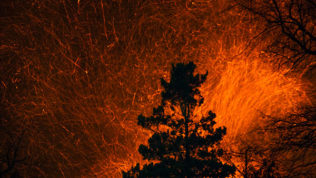Wind can push wildfire embers into unprotected openings around your home.
You’ve taken the precautions to make your home resistant to wildfire by installing non-combustible siding and roofing, removing all wood attachments, managing vegetation and landscaping and providing adequate defensible space, yet you may still be at risk.
Your ventilation system could leave your home vulnerable in a wind-driven wildfire. A typical home may have gable-end, soffit, dormer, foundation or ridge vents – all potentially susceptible to ember intrusion.
According to Cal Fire – the California Department of Forestry & Fire Protection – flying embers from a wildfire can destroy a home up to a mile away. Embers, also called firebrands, are responsible for the destruction of most homes during a wildfire. Embers can ignite combustible material directly and cause spot fires capable of igniting a building. If enough wind-blown embers enter a building through a vent, they can ignite combustible materials in the attic and result in the building burning from the inside out.
Some vents in a home (such as vents in an under-eave area) are considered inlet vents while others (such as roof or gable-end vents) are considered outlet vents. However, any vent can become an inlet vent when wind blows against the house, researchers have found.
Consider these steps to ensure that all openings in your home can resist embers.
- If you are building a new home or renovating an existing home:
- Choose a soffited eave design instead of an open eave design for under-eave inlet vents.
- For outlet vents, choose vents that have an external baffle at the vent inlet.
- Check with local building code officials or your state’s office of the fire marshal for vents approved for use in your jurisdiction.
- Use mesh screening to reduce ember entry. Typically, building codes require vent openings to be covered by one-quarter inch mesh. However, wildfire research has shown that embers can pass through quarter-inch meshing and ignite combustible materials. Experts recommend that eighth-inch meshing be used in wildfire-prone areas.
- Keep your attic area clear of combustible material such as newspaper or cardboard boxes. These materials can be ignited easily if embers make their way into your home.
- Maintain sufficient defensible space around your home and maintain trees and landscaping to prevent flammable vegetation from growing up against or touching your home in any way.
- Replace combustible siding, roof and attachments with non-combustible construction materials.
MORE INFORMATION
National Fire Protection Association: Preparing homes for wildfire
National Interagency Fire Center: Wildfire Mitigation
This loss control information is advisory only. The author assumes no responsibility for management or control of loss control activities. Not all exposures are identified in this article. Contact Landmark Risk Management & Insurance for coverage advice and policy service.

